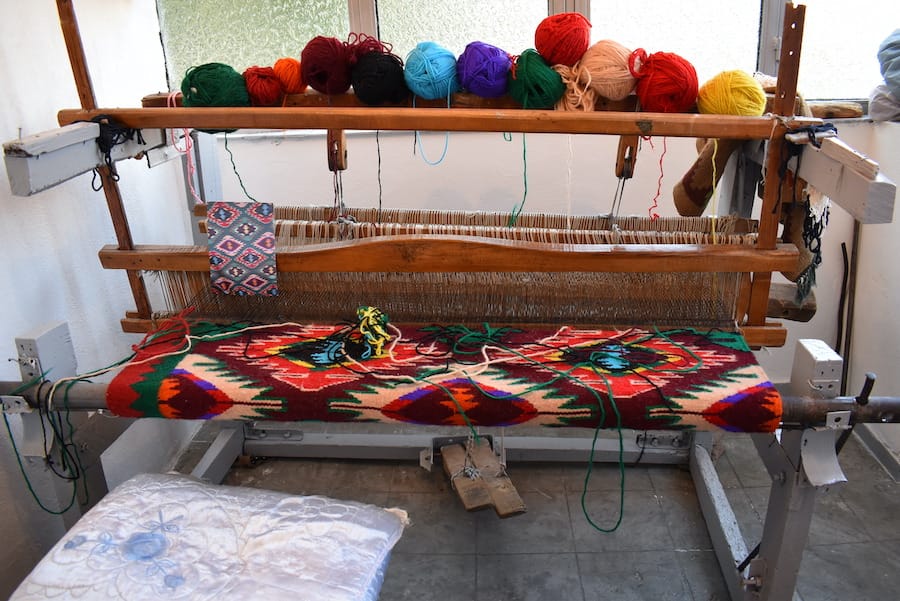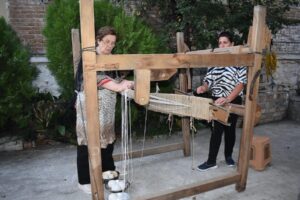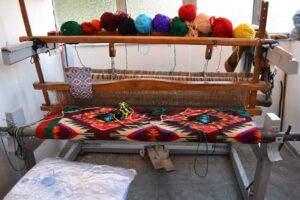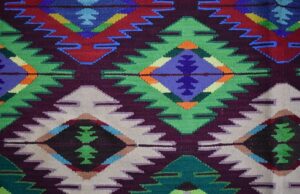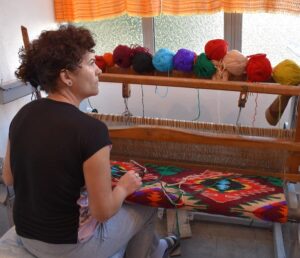The first step of wool processing is the shearing of Rude sheep, as this breed is native to the area.
The woolstock is washed at home manually, flung in postaf or water trough (garden tap) to rinse from the mud, bur and dirt already stuck onto the sheep when in the pasture.
After rinsing, bashka (the wool shorn fleece) is stuffed into a large container, bucket, or bin, adding lukewarm water and grated soap, and letting it sit for almost 2 hours in order to get rid of dirt and grease.
Then rinsing of wool runs in parts, with plentiful water. It is thereupon hung up to drip-dry on racks or grids.
Çëpkatja is the next step after the wool has dried up. Çëpkatje means disentangling wool fibers by hand to prepare them for carding and to take the leftover dirt out.
The disentangled fleece is then passed through a carding machine turning into “kuvaristë” (spool of wool) for spinning. Spinning is carried out with a distaff when the wool comes in a hank or skein and with a spindle when the wool comes in the spool.
The yarn obtained from the spinning is made into tufts and then passed through the dyeing process, which is applied with plant-based dyes such as cacaniku (walnut husks), quince leaves, red onion skins, mustard, and spinach leaves, from which black and green color are obtained. The dyeing is plant-based as it prevents wool fibers from scarring. During dyeing, the wool tufts are stirred with a wooden stick inside the container, so that the wool takes on a color homogeneity.
Following the above dyeing process, which is applied in copper or aluminum containers placed over a wood fire, the scoured wool tufts are dried up and then coiled into skeins separated out by color and inserted into the loom.
The next step after dyeing the wool is weaving which is the basic and main process for making a rug/carpet.
At the beginning of this process, the warp yarn is taken (cotton thread in two-ply black and white colors). This element is found in the market. Each ball of yarn is inserted into separate containers. This process continues with passing each yarn through a reed built with holes, so to prevent yarns from raveling and the next weaving follows. Several large pins-type are fixed onto the ground in a way to form the “mouth of heddles”. The weave runs in an 8-form pattern, namely, the longitudinal warp threads are held stationary under tension to allow for transverse weft threads to run across. Then this stock yarn is carried around the shuttle which is mounted on the loom to weave.
After this process, the yarn undergoes përlisja (heddling) thereby passing through the heddles, mindful to form the tool “mouth”, which serves to change the row during the rug weaving (this is done with two treadles located below the floor loom under the artisan’s feet). The heddling process continues with passing the yarn through the reed. The reed teeth consist of ebonite material so as to avoid breaking. The reed slides into a trough and sits into bërdillë (beater bar) which serves to compress the woven workpiece so that the yarn does not skip in the process of the product (rug/carpet) weaving.
What comes next is the connection with the next shuttle to begin the weaving process, mindful of the pattern to be woven.

